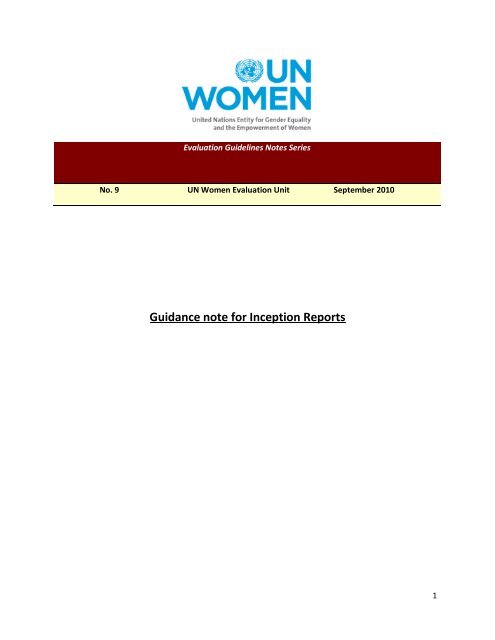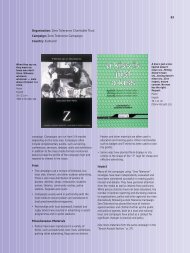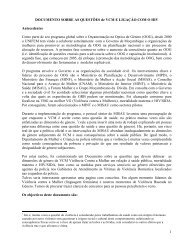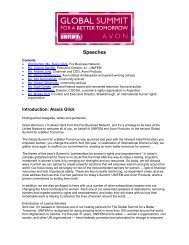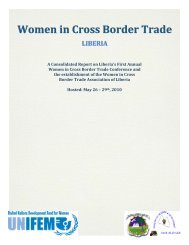Guidance note for Inception Reports - UN Women
Guidance note for Inception Reports - UN Women
Guidance note for Inception Reports - UN Women
You also want an ePaper? Increase the reach of your titles
YUMPU automatically turns print PDFs into web optimized ePapers that Google loves.
Evaluation Guidelines Notes Series<br />
No. 9 <strong>UN</strong> <strong>Women</strong> Evaluation Unit September 2010<br />
<strong>Guidance</strong> <strong>note</strong> <strong>for</strong> <strong>Inception</strong> <strong>Reports</strong><br />
1
Introduction<br />
This guidance has two aims: (1) to assist Evaluation Teams in the preparation of the inception report <strong>for</strong><br />
evaluations; and (2) to assist Geographic, Thematic Sections and Sub-Regional Offices (SRO) in reviewing<br />
the inception report prepared by the Evaluation Team.<br />
What is the inception phase?<br />
<strong>Inception</strong> meeting: Within a few weeks after the start of the evaluation work, and after a review of<br />
basic documents complemented by a few interviews, the evaluation team defines its overall approach.<br />
This approach is presented in an inception meeting with the evaluation manager and the reference<br />
group members. Subjects to be discussed include: (1) Logical framework; (2) Evaluation questions, either<br />
from the Terms of Reference (ToR) or proposed by the evaluation team; (3) Provisional methodological<br />
design; and (4) Access to in<strong>for</strong>mants and to documents, and <strong>for</strong>eseeable difficulties.<br />
The presentation is supported by a series of slides and by a commented list of evaluation questions.<br />
Where relevant, the meeting may be completed by an email consultation.<br />
<strong>Inception</strong> report: Based on the inception meeting and the preliminary desk review, the evaluation team<br />
should develop an inception report. The inception report provides in<strong>for</strong>mation on what has been done<br />
to initiate the evaluation 1 and the action plan <strong>for</strong> the future. It includes the evaluation team’s<br />
understanding of how the programme/project is supposed to work, including strategies, activities,<br />
outputs and expected outcomes and their interrelationships. It also describes the conceptual framework<br />
<strong>for</strong> the evaluation, and sets out in some detail the evaluation methodology, i.e. how each question will<br />
be answered by way of data collection methods, data sources, sampling and indicators. The report also<br />
contains a work plan, which indicates the phases of the evaluation with their key deliverables and<br />
milestones.<br />
The inception report is reviewed and approved by the evaluation manager, <strong>UN</strong> <strong>Women</strong> and the<br />
evaluation reference group.<br />
Who needs an inception report?<br />
The evaluation team: The evaluation team should develop and inception report. The inception report<br />
explains the expectations and objectives around the assignment. It provides detailed in<strong>for</strong>mation based<br />
on the inception meeting, including the background and the context of the programme/project and of<br />
the evaluation, intended audiences and uses.<br />
The evaluation manager: The evaluation manager receives an inception report which finalizes the<br />
questions and describes the main lines of the methodological designs, including the indicators to be<br />
used, the analysis strategy, and a detailed work plan <strong>for</strong> the next step.<br />
1 For instance, progress of the documentary analysis and meetings.<br />
2
Stakeholders: The inception report explains what has been done to initiate the evaluation and the plan<br />
<strong>for</strong> action. In addition, it explains the agreed expectations among the different stakeholders and process<br />
of the evaluation and is a guide to each stakeholder’s specific roles.<br />
What are the guiding principles?<br />
The inception report should comply with United Nations Evaluation Group (<strong>UN</strong>EG) Norms and<br />
Standards. 2 It should be coherent with the <strong>UN</strong> <strong>Women</strong> evaluation policy and strategy, and <strong>UN</strong> <strong>Women</strong>’s<br />
Result Based Management principles should guide the development of inception report.<br />
Since Human Rights (HR) and Gender Equality (GE) are central to the <strong>UN</strong>’s mandate and all of its work,<br />
these elements also need to be included in evaluations. The key guiding principles in integrating HR and<br />
GE in evaluation are: (1) Inclusion; (2) Participation; (3) Fair power relations; and (4) Mixed methods. 3<br />
What should the inception report include?<br />
The inception report should include 4 :<br />
1. Introduction<br />
Describe the programme being evaluated, drawing from relevant documentation, particularly<br />
the desk review. 5 State the purpose of the programme clearly.<br />
State the purpose, scope and use of the evaluation. 6 This includes the background of the<br />
programme and a brief explanation of why the organization decided to conduct an evaluation<br />
and how the evaluation results will be used and by whom. Include the complete set of<br />
evaluation questions and elaborate on them as necessary. Make sure that HR and GE aspects<br />
are well incorporated in the evaluation questions. 7 Any questions added during the contract<br />
negotiations must be clearly indicated and any deleted questions must be mentioned with a<br />
reason as to their exclusion.<br />
2 Please see also <strong>UN</strong>EG Quality Checklist <strong>for</strong> Evaluation ToR and <strong>Inception</strong> Report:<br />
http://www.uneval.org/normsandstandards/index.jsp this guidance is from the <strong>UN</strong>EG. For <strong>UN</strong> <strong>Women</strong> purposes,<br />
the document is more helpful <strong>for</strong> developing a ToR.<br />
3 Please see <strong>UN</strong>EG Handbook <strong>for</strong> Integrating Human Rights and Gender Equality Perspectives in Evaluations in the<br />
<strong>UN</strong> System<br />
4 You may use this section as a checklist <strong>for</strong> reviewing the quality of the inception report.<br />
5 The desk review includes a collection of all documents on the project, reports, minutes, lectures, schedules and<br />
proposals. The inception report draws on these sources.<br />
6 This is usually set out in the ToR. If any modifications are made during the inception phase, it should be clearly<br />
indicated.<br />
7 Please see <strong>UN</strong>EG Handbook <strong>for</strong> Integrating Human Rights and Gender Equality Perspectives in Evaluations in the<br />
<strong>UN</strong> System. The Handbook has “Framing the valuation question <strong>for</strong> the analysis”: (1) of design and planning; (2) in<br />
implementation; and (3) of results at the outcome and impact level.<br />
3
2. Evaluation framework<br />
2 Evaluation f<br />
Discuss the overall approach of the evaluation, highlighting the type of the evaluation and the<br />
conceptual model(s) adopted. This should incorporate an analysis of the intervention logic of the<br />
programme. 8 The intervention’s theory of change includes attention to GE and HR.<br />
Discuss risks and limitations that may undermine the reliability and validity of the evaluation<br />
results. This can also include access to in<strong>for</strong>mants and to documents, and <strong>for</strong>eseeable difficulties.<br />
3. Evaluation methodology<br />
Review existing data. List interviews, questionnaires, field <strong>note</strong>s, scientific testing, surveys,<br />
reviews of literature, or whatever data collection methods used during the programme planning,<br />
implementation and monitoring, and use charts, graphs, and lists to effectively display data that<br />
has already been collected, if any.<br />
Specify indicators <strong>for</strong> each question that will be used as a guide in answering the question. List<br />
additional indicators on GE and HR if they are not clearly articulated.<br />
Discuss the data collection and data analysis methods that will be used <strong>for</strong> each question. State<br />
the limitations <strong>for</strong> each method. Include the level of precision required <strong>for</strong> quantitative methods<br />
and value scales or coding used <strong>for</strong> qualitative methods. Standard data collection methods <strong>for</strong><br />
<strong>UN</strong> <strong>Women</strong> evaluations are: surveys, questionnaires, interviews, focus groups, document review<br />
and observation. Other new and innovative methods e.g. debates, photography, video records,<br />
log diaries, rating scales, knowledge test, are also encouraged to use.<br />
Pure or mixed methods design. 9 Determine whether the evaluation will be purely<br />
qualitative, quantitative, or a mixed method design with both qualitative and<br />
quantitative data. If the evaluation team chooses mixed methods, plan to synthesize<br />
qualitative and quantitative in<strong>for</strong>mation.<br />
(For qualitative methods) Discuss qualitative design strategies and details. Describe<br />
qualitative design strategies, data collection options, and analysis approaches.<br />
Determine which qualitative evaluation applications are especially appropriate given the<br />
evaluation’s purpose and priorities. 10<br />
8 The Evaluation Unit (EU) has recently noticed some confusion with “Theory of Change” – in some cases, there is a<br />
misunderstanding that a “Theory of Change” is supposed to be developed by the evaluation team rather than<br />
developing it at the programme planning phase. When a “Theory of Change” does not exist, the evaluation team<br />
could reconstruct it during the inception phase, but this is not standard practice.<br />
9 Evaluating human rights and gender equality should use both quantitative and qualitative methods. The <strong>for</strong>mer<br />
can give credible in<strong>for</strong>mation about the extent of results <strong>for</strong> particular groups of stakeholders, while the latter can<br />
assist in explaining how those results are achieved. (Please see <strong>UN</strong>EG Handbook <strong>for</strong> Integrating Human Rights and<br />
Gender Equality Perspectives in Evaluations in the <strong>UN</strong> System)<br />
10 For qualitative evaluation checklist, “Qualitative Evaluation Checklist” by Michael Quinn Patton is useful:<br />
http://www.wmich.edu/evalctr/archive_checklists/qec.pdf<br />
4
(For quantitative methods) Discuss the sampling methods and details. Describe the<br />
area and population to be represented, rationale <strong>for</strong> selection, mechanics of selection,<br />
sample size, sample precision, confidence levels and limitations.<br />
Participatory evaluation: 11 The following participatory processes need to be ensured:<br />
(1) <strong>Inception</strong> phase – the evaluation team extends its initial interviews in order<br />
to understand the expectations of beneficiaries and other outside stakeholders.<br />
A stakeholder analysis is per<strong>for</strong>med and discussed in the inception meeting. 12<br />
(2) Work plan - the work plan involved a series of workshops or focus groups<br />
allowing <strong>for</strong> beneficiaries to frame the date that are being gathered. 13<br />
(3) Debriefing – the evaluation team may hold debriefing workshops involving<br />
beneficiaries and other external stakeholders, with a view to strengthening the<br />
quality of collected data, to interpreting data from the viewpoint of field-level<br />
stakeholders, and to empowering civil society organizations locally. 14<br />
Present the key data sources that will be selected to answer each of the evaluation questions<br />
posed. Common sources include: programme stakeholders and partners, programme<br />
documents, programme records, in<strong>for</strong>mation systems/databases, etc. 15<br />
Summarize the evaluation methodology in an evaluation planning matrix containing the<br />
following column headings: evaluation question, indicator(s), data collection method(s), data<br />
source, sampling and comments.<br />
Evaluation Planning Matrix<br />
Evaluation<br />
Question<br />
Indicator(s)<br />
Data<br />
Collection<br />
Method(s)<br />
Data<br />
Source<br />
Sampling<br />
Comments<br />
11 Evaluating human rights and gender equality should be participatory. Stakeholders of the intervention have a<br />
right to say about what will be evaluated and how the evaluation will be done (please see <strong>UN</strong>EG Handbook <strong>for</strong><br />
Integrating Human Rights and Gender Equality Perspectives in Evaluations in the <strong>UN</strong> System)<br />
12 Please see “what is inception phase?” on page 2.<br />
13 <strong>UN</strong>EG Handbook <strong>for</strong> Integrating Human Rights and Gender Equality Perspectives in Evaluations in the <strong>UN</strong> System<br />
has a table <strong>for</strong> Stakeholder Analysis.<br />
14 Please see 4. Work plan on page 6.<br />
15 The evaluation team should ensure that all relevant existing sources of data and research on women in the<br />
country and in the region is identified and reviewed <strong>for</strong> possible use. These would typically include: the country<br />
reports on the Convention on the Elimination of All <strong>for</strong>ms of Discrimination Against <strong>Women</strong> (CEDAW) and the<br />
observations of the CEDAW Committee, routine statistics generated by Ministries or Statistics Offices, specialpurposes<br />
surveys such as Census and Demographic and Health Surveys (DHS), sectoral and macro-level analysis<br />
and programme evaluations undertaken by the government or other partners, local level studies, legislative and<br />
budget review etc.<br />
5
4. Work plan<br />
Develop a timeline which shows the evaluation phases (data collection, data analysis and<br />
reporting) with their key deliverables and milestones. Describe what has been done so far,<br />
listing meetings, locations, attendees, and conclusions. A detailed work plan includes clear steps<br />
and goals, including dates, places and personnel involved. For ease of reading, the working<br />
schedule is often presented in a chart <strong>for</strong>mat.<br />
Specify responsibilities <strong>for</strong> the evaluation team members, the evaluation manager and the<br />
reference group.<br />
5. Logistics<br />
Discuss the logistics of carrying out the evaluation. Include specific assistance required from <strong>UN</strong><br />
<strong>Women</strong> such as providing arrangements <strong>for</strong> visiting field offices or sites.<br />
6. Appendices<br />
Append relevant draft data collection instruments, such as questionnaires and interview guides,<br />
lists of evaluation team members, phone numbers, a glossary, or minutes of meetings.<br />
Append the ToR.<br />
Append CVs of the evaluation team members.<br />
Good practice<br />
The commissioning unit i.e. <strong>UN</strong> <strong>Women</strong> and the evaluation reference group should review and assure<br />
the quality of the inception report. The inception report provides an opportunity to clarify the process,<br />
resources requirements and dates <strong>for</strong> deliverables – at an early stage of the evaluation exercise and<br />
ensure that the commissioning party and the evaluators have a common understanding on how the<br />
evaluation will be conducted. 16<br />
You may also consider having a stakeholder workshop on the draft inception report to encourage wider<br />
participation in the evaluation process. This will help to: (1) bring the collaborating organizations and<br />
partners together to agree on details regarding the scope of the evaluation, arrangements <strong>for</strong><br />
collaboration, and a work plan; and (2) discuss concept, methods, and approaches <strong>for</strong> the analyses.<br />
This guidance <strong>note</strong> was prepared by Yumiko Kanemitsu in collaboration with <strong>UN</strong> <strong>Women</strong> (part of <strong>UN</strong><br />
<strong>Women</strong>) Evaluation Team. Reviewed in December, 2010.<br />
16 Note that the inception phase is a negotiation phase as well. Some issues such as timelines and the degree of the<br />
participatory approach need to be agreed among the stakeholders. It is also important to discuss the accessibility<br />
of the in<strong>for</strong>mation and the data, and alternative methods in the case the data is not available.<br />
6
References/Literatures consulted:<br />
1. <strong>UN</strong>DP (2009): HANDBOOK ON PLANNING, MONITORING AND EVALUATING FOR DEVELOPMENT<br />
RESULTS<br />
2. <strong>UN</strong>ESCO (2008): Guidelines <strong>for</strong> <strong>Inception</strong> <strong>Reports</strong><br />
3. <strong>UN</strong>EG (2010): Handbook <strong>for</strong> Integrating Human Rights and Gender Equality Perspectives in<br />
Evaluations in the <strong>UN</strong> System<br />
4. How to write an inception report: http://www.ehow.com/how_5835218_write-inceptionreport.html<br />
5. Evaluation Checklists Project of the Evaluation Center of Western Michigan University:<br />
http://www.wmich.edu/evalctr/checklists/evaluation-models/<br />
6. EuropeAid, Project/Programme Evaluations Guidelines <strong>for</strong> the Manager:<br />
http://ec.europa.eu/europeaid/evaluation/methodology/guidelines/gba_det_en.htm#02_01<br />
7


